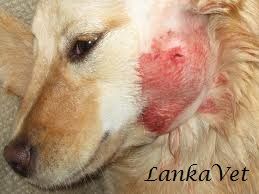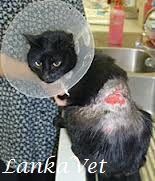An abscess is a collection of pus encapsulated within a tissue underneath the skin. It occurs when the body tries to fight an infectious process usually caused by bacteria or parasites within the body tissues, sending white blood cells to fight further infection.
An abscess may first appear as a painful firm swelling under the skin that is hot or cold to the touch. In later stages, the localized swelling often becomes softer and less painful. This usually happens right before the abscess is getting ready to burst and drain.
Abscesses around the neck and tail are far most common in cats who have access to the outdoors and who play territorial games with their fellow cats. Their teeth and claws are extremely contaminated with bacteria, and when they are sunk into the skin of the opposing cat, the bacteria becomes embedded under the skin. Pasteurella multocida is the most common bacteria to cause skin infections.
Causes
The most common causes of abscesses include:
- Animal bites
- Scratches
- Trauma to the skin or underlying tissues
- Foreign object penetration
- Bad oral hygiene
How does it occur?
 For an abscess to occur, the pet must have been injured somehow. They are caused by obstruction of oil (sebaceous) glands or sweat glands, inflammation of hair follicles, or minor abrasions and punctures of the skin. Germs get under the skin or into these glands, which causes an inflammatory response as your pet's natural defense mechanisms kick-in to remove the foreign body.
For an abscess to occur, the pet must have been injured somehow. They are caused by obstruction of oil (sebaceous) glands or sweat glands, inflammation of hair follicles, or minor abrasions and punctures of the skin. Germs get under the skin or into these glands, which causes an inflammatory response as your pet's natural defense mechanisms kick-in to remove the foreign body.
The middle of the abscess liquefies and contains dead cells, bacteria, and other debris. This area begins to grow, creating tension under the skin and further inflammation of the surrounding tissues. Pressure and inflammation cause the pain.
Pus is formed when the white blood cells die and accumulate in the affected area. As a protective mechanism, the immune system also works to wall off this area from the rest of the body, by forming a fibrous capsule. This fibrous capsule keeps the pus confined to one area. If the bacteria or foreign material overwhelms the immune system, the pus continues to accumulate and the abscess becomes larger.
As time goes on, the wall surrounding the ever-growing pus pocket becomes thin, and at some point, it ruptures and pus drains out. Typically, the abscess ruptures to the exterior of the body, and pus drains from the wound. The pus is usually quite thick and creamy, and often has a distinct smell. However, in many cases; the abscess may not drain naturally and must be excised by a vet.
- Swelling and inflammation
- Heat and redness around the area
- Pain around the area of infection
- High temperature or fever
- Lack of appetite
- Lethargy and a reluctance to move
- Rotting teeth, tooth loss, excessive saliva and bad breath (in mouth abscesses)
- Hair loss (in skin abscesses)
- Stiffness or lameness (abscesses around joints)
- Licking or grooming affected area excessively
- Foul odor
- Purulent discharge (pus) from a wound
- Abscess drainage is painful and better to do it under anesthesia
- Painkillers
- Antibiotics to avoid secondary bacterial infections - Topical & intramuscular
- Clindamycin - If it is serious or deep in the skin
Caring and Management
- Clean hands thoroughly before handling abscess.
- Clear the surrounding skin by clipping away hair with a small pair of scissors.
- Gently clean the area with a mild soap and then rub it with clean gauze soaked with antibacterial solution, Ex. saline solution or hydrogen peroxide.
- Gently pat the area dry with a towel.
- Drain the abscess via surgical puncture and then drain with a sterile solution such as normal saline.
- Abscesses are usually left open and allowed to drain to prevent the re-infection.
- Use a topical skin protecting agents, such as Betadine, to guard the skin against bacterial infection and keep the affected area clean.
- Check it every 12 hours. Gently remove any scabs or crusts skin that have formed and clean the area with soap and water apply Betadine ointment.
- If you come in contact with draining pus, just wash your hands. These bacteria may infectious to humans if it is exposed to an open wound on skin.





No comments:
Post a Comment